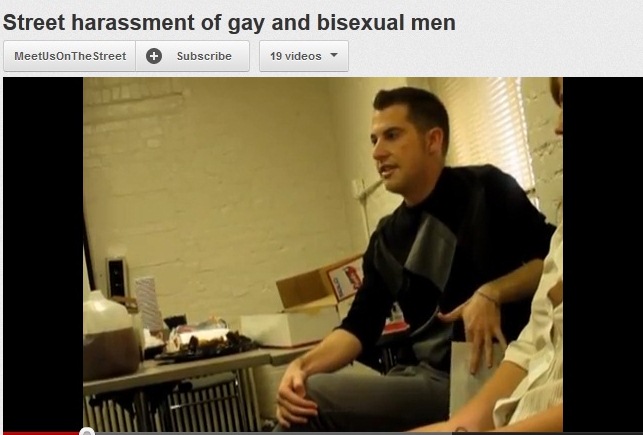This is a guest post by Patrick McNeil and cross-posted with his permission from Feministe. Patrick is finishing his master’s thesis at The George Washington University in Washington, D.C., where he is pursuing his Master’s in Women’s Studies. His work focuses on whether and how gay and bisexual men experience street harassment and how this form of harassment intersects with and diverges from the gender-based street harassment of women. Follow him on Twitter at @patrickryne.

While waiting for a bus on my way to work, a man approached me and asked about the bus schedule. Then, he asked if I liked him. He said he was on the DL, that he liked my voice and thought I was sexy. I grew uncomfortable, and wasn’t sure how to respond. He then questioned whether I liked big black cock and asked if I wanted to see his. His aggression was unwanted and it took awhile to convince him that I wasn’t interested.
Another time while walking through a metro station, I was harassed for holding hands with another boy.
As much as I wish these incidences were rare, they’re not – and that’s the reality for many men who are perceived to be either gay or bisexual.
Lately, we’ve heard a lot about the street harassment of women, from a CNN.com homepage feature to a skit on Saturday Night Live, and while the focus on the gender-based street harassment of women needs even more attention than it’s getting now, the harassment of men is an interrelated issue that deserves some attention, too.
Earlier this year, I conducted research as part of my master’s thesis at The George Washington University about the street harassment of gay and bisexual men. I surveyed 331 men around the world about their experiences, and about 90 percent said they are sometimes, often, or always harassed or made to feel unwelcome in public spaces because of their perceived sexual orientation – a figure that is far too high.
But the harassment of gay and bisexual men is complicated. They’re targeted because they are men, and they’re targeted because their masculinity is, in some cases and to varying degrees, illegible. It’s a form of violence that takes place in a heterosexist society, one that tries to enforce traditional gender standards and behaviors on individuals engaged in public interaction.
The types of harassment my respondents experienced tended to vary based on the sexual orientation of the harasser. They reported that it was other gay or bisexual men who whistled at them and touched/grabbed them in a sexual way, while men who they identified as straight were more responsible for other things, like honking, swearing, making homophobic comments, purposely blocking a path, or following.
Many men reported toning down their appearances in public to appear more masculine and avoid harassment. One respondent said he was uncomfortable around guys he referred to as “bros,” even though he had little experience being harassed by them.
And this is what I find so unsettling about this form of violence. Though it may happen less often than the gender-based street harassment of women, gay and bisexual men still think about and, at times, agonize over it. In fact, about 71 percent of my survey respondents reported constantly assessing their surroundings when navigating public spaces.
In addition, 69 percent said they avoid specific neighborhoods or areas, 67 percent reported not making eye contact with others, and 59 percent said they cross streets or take alternate routes – all to escape potential harassment.
Women and men should not feel afraid walking to the store or to work, or riding a bus or subway, and they certainly should not have to take extreme measures like switching jobs or moving residences just to avoid the unwanted attention they get in public spaces. This is a major social problem and something must be done to combat it.
First, we need to speak up when we witness acts of public harassment and we need to encourage more men to speak out about the issue, including when they’re being harassed. By speaking out and sharing our stories, we can work toward a culture that does not dismiss public harassment as the price you pay for being a woman, or for being perceived as a gay or bisexual man.
Second, we need to know more about street harassment, an under-researched issue. Stop Street Harassment, a new nonprofit organization, plans to conduct a nationally representative study on street harassment that will provide us with data about the harassment both women and men experience and the impact it has on their lives. Unlike my opt-in, informal survey, this study will produce nationally representative data that is desperately needed to help us understand the issue. But this study will only be possible with our help, so consider donating online now.
And finally, we have to keep talking about street harassment because, well, it’s happening right now. And it’s happening everywhere. And everyone needs to know about it.
